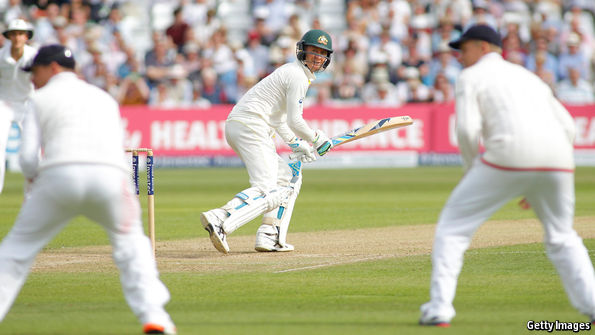Bye-bye bilaterals – The Economist (blog)

ACROSS the world, team-sport competitions tend to be organised around one of two principles. Either teams play one another in a round-robin league, or they lock horns in a knockout competition that leaves only the winner standing. (Or, sometimes, a combination of the two.) At the end of it all, there is an easily identifiable winner.
But not all follow this route. Some sports hold a number of one-off bilateral competitions, with nothing at stake other than the pride of beating your opponent. Rugby is one such, particularly series involving the British & Irish Lions; hockey (field hockey to Americans) is another. But cricket is the exemplar. In Test matches, which are considered the most prestigious form of the game, there has never been a World Championship, nor any greater context to matches than rankings, which are hard to understand and can give little indication of a side’s true worth.
This is partly down to the way that Test cricket evolved. It began, in 1877, with just two nations, England and Australia. South Africa joined them shortly after. But it wasn’t until 50 years after the first Test match that a fourth, the West Indies, joined the exclusive club. Hence, the onus was, from the start, on bilateral series.
One consequence of this has been a lopsided fixture list, with the wealthiest nations playing each other the most, regardless of their on-field quality. Michael Clarke (pictured), a former Australian captain who retired last year, played 57 of his 115 Test matches against either England or India. Such scheduling can result in short-term profits for countries. But ultimately the proliferation of matches between a small number of teams risks undermining the value of the sport. Across the three formats of cricket, England played Australia, their biggest rivals, 40 times between June 2013 and September 2015. Compare that with international football, which is far more structured, with teams qualifying for important knockout tournaments through leagues. In that sport, England have only ever played Germany, their traditional rivals, 30 times since their first official meeting in 1930. “One of the greatest creators of value is scarcity,” says Andrew Wildblood, a former executive vice-president of IMG, a sports marketing firm. “That currency is under threat of devaluation.”
Hence, cricket fans are losing their appetite for Corinthian contests between two sides in favour of matches that have a wider context. Outside of the iconic Ashes Tests, which have been played between Australia and England every few years since 1877, bilateral series are struggling to generate interest among the public and broadcasting rights have been stagnating. At the same time, the value of international cricket’s multi-team events—the 50-over World Cup and Champions Trophy, and the World Twenty20 competition—has risen dramatically. The TV rights for these events from 2015-23 were sold for $2.5 billion, compared with $1.1 billion for the 2007-15.
David Richardson, chief executive of the International Cricket Council (ICC), which runs the global game, has warned that “interest in Test cricket will continue to waver” unless greater context is introduced. So it is suggesting a radical overhaul. It wants to introduce a top division of seven teams and a second tier of five, with promotion and relegation every two years, in a league structure. The reforms could be in place from 2019, with something similar being discussed for one-day international cricket too.
This would be fairer, because it would allow countries to rise and fall based solely on on-field performance. But just as importantly, it would also hold greater appeal to broadcasters, who can sell games as part of a broader narrative. It might even encourage supporters to watch matches not involving their own countries, because the result in one match would have an impact on other nations’ prospects. If a small percentage of India’s legion of cricket fans gained a new reason to watch England play Sri Lanka in Test matches, for instance, the economics of the game could be transformed.
Should plans go ahead (which will depend on whether seven of the ICC’s ten full-member nations vote them through), it would continue a broader trend. In April, hockey’s governing body unveiled a new structure, creating a global league involving the world’s leading nations from 2019. This, it thinks, could significantly increase the sport’s commercial appeal. And while 15-a-side rugby, like cricket, still has plenty of bilateral series, they no longer hold the appeal of the tournaments such as the Six Nations or Rugby Championship.
Indeed, the game could probably learn much from rugby sevens, a short-sided format, which has benefited from a structure with a clear global context. In 1999, the World Rugby Sevens Series was created; it has since expanded to ten events every year, progressing towards an overall winner. The game’s popularity (also aided by its inclusion in this year’s Olympic Games) has risen significantly, as a result.
A few marquee events—the Lions tour in rugby, the Ryder Cup in golf, and the Ashes in cricket—still have enough prestige to thrive as stand-alone bilateral events. But for the rest the message is clear: today’s sports fans crave wider context not Corinthianism.



